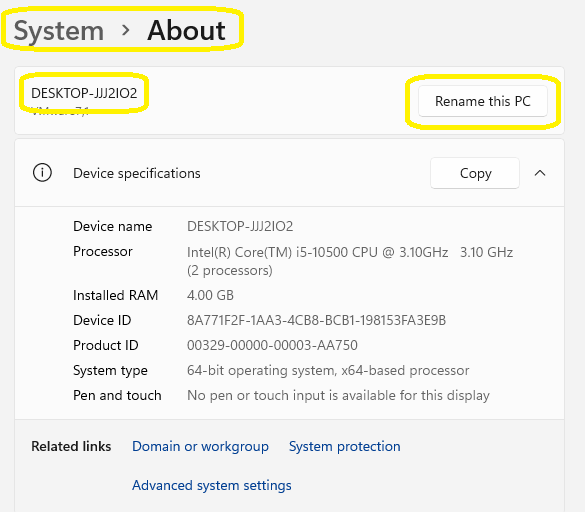This procedure is for existing non-domain joined devices which would opt for the device management scheme, see Device management using Microsoft Intune
- For those existing devices that has already joined to on-premises domain, you can keep using the device without onboarding Microsoft Intune. Should there be upgrade or replace of such devices, ITSC recommend onboarding to Microsoft Intune.
- If your device has already joined on-premises domain, and if you would like to enjoy the advanced protection mechanism provided by Intune, you may send us a mail (cchelp@ust.hk). ITSC will provide custom procedures for hybrid-join (attach device to both on-premises AD and Microsoft Intune).
This option allows user to keep existing user data and configurations (user profile). Upon successful onboarding, the device can be protected by Microsoft Intune. User may then choose to:
- Add ITSC account to current user.
One can then access eligible cloud resources like Office 365, OneDrive, Teams etc... The existing user data, configuration and applications are kept. But this profile cannot readily access on premise domain resources like network shares. Additional configuration or login may be needed. - Login the device using ITSC account.
A new user profile will then be created. One can readily access on premise domain resources without further logon. Eligible cloud resources are also available. To access existing user data, you may need to re-login using existing account.
Steps to be performed by device user
A. Make sure the device is running in Windows 10/11 Professional or Enterprise editions
To enroll Microsoft Intune, Windows device must of Professional and Enterprise edition. To check your device Windows version, under "Setting", "System", "About", you can verify Windows Edition at "Windows Specifications" section.
If the Windows version is not Professional or Enterprise, you may:
| Windows 10 | Windows 11 |
|---|---|
|
Open "Settings", "Update and Security", "Activation". Make sure your device's Windows version is Windows 10 Home, then click "Change product key". |
Open "Settings", "System", "Activation". Make sure your device's Windows version is Windows 11 Home, then at the "Change product key" row, click "Change" |
|
Now, at the "Enter a product key" dialog, enter the Enterprise KMS setup key You'll then be prompt to upgrade your edition of Windows, just press "Start" to begin upgrade process. The upgrade process may take a few minutes and your device will restart after upgrade. |
|
B. RENAME DEVICE
At this stage, the device will have arbitrary computer name like "DESKTOP-ABCDEFG" or "LAPTOP-ABCDEFG". ITSC imposes no restriction on computer name for new Windows 10/11 devices enrolling to Intune. However, we strongly recommend changing your device name at this stage. By changing device name now will give you ease to manage devices. Also, it'll help to locate the device should there be security alerts raised in future. ITSC would like to suggest using the following naming conventions:
- [dept]-[Abbreviation or Team or Owner]-[sequence]
e.g., ITSC-DIR-001, ITSC-PROJ-001 or ITSC-CCTEST-001
To do so, in "Settings", "System", "About", click "Rename this PC".
| Windows 10 | Windows 11 |
|---|---|
 |
 |
After renaming PC, a reboot is required to make changes effective.
C. KEEP THE CURRENT device AND JOIN AAD as added protection
This option is used for non-domain joined device who want to keep everything and join AAD with Microsoft Intune to enjoy added security feature. The following procedure is the same for both Windows 10/11.
- Open "Settings", "Accounts", "Access work or school", click "Connect"
- On the "Set up a work or school account", select "Join this device to Azure Active Directory"

- Now, sign in with your ITSC credential. Upon completion, You may now reboot your machine.
D. ADD ITSC ACCOUNT TO CURRENT USER
This option allows current (non-ITSC account) user to access eligible cloud resources like Office 365, OneDrive and Teams. The following procedure is the same for both Windows 10/11.
- Open "Settings", "Accounts", "Email & accounts", click "Add a work or school account"
- Now, sign in with your ITSC credential.
- Upon completion, open your applications like OneDrive or Teams. Click "Sign-In". You only need to type your ITSC Email address and then you can access the application without providing password.
E. Verify Intune Enrollment
- Verify Intune Enrolment
You can verify your device enrolment status by checking the presence of "Managed by HKUST - Info" under "Settings", "Accounts", "Access work or school", "Connected to HKUST's Azure AD".Windows 10 Windows 11 

- Verify Microsoft Defender for Endpoint protection.
Your device should also be protected by the Microsoft Defender for Endpoint. This could be verified by checking the presence of "ITSC Support" under the "Windows Security" application page.
